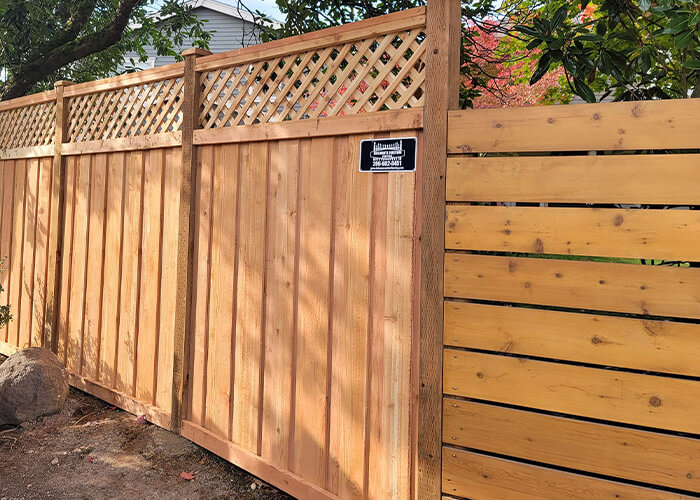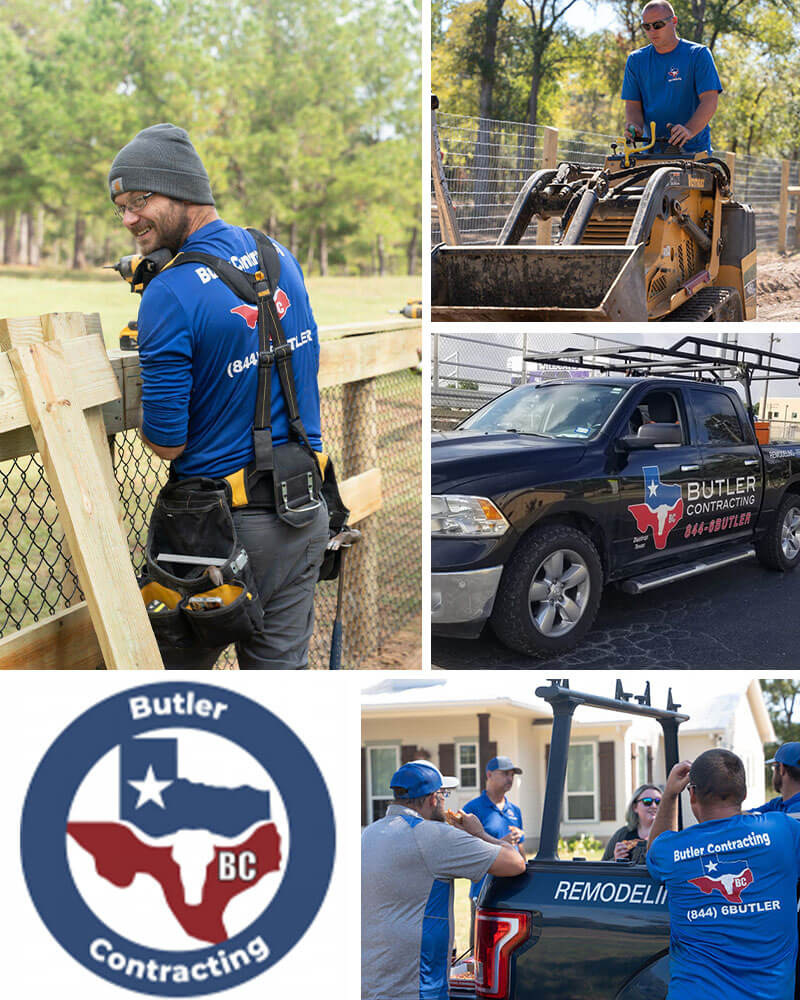Just How to Recognize Common Concerns That Require Immediate Fencing Repair Service
It is important to find concerns prior to they end up being larger troubles when it comes to keeping your fence. Regularly inspecting for indications of decomposing wood, leaning panels, or rust can save you time and money in the future. You may not recognize how weather and pests can compromise your fencing's integrity. Allow's check out the usual signs that indicate your fencing requires immediate interest, so you can maintain your residential or commercial property secure and looking its ideal.
Signs of Rotting Timber in Wooden Fences
Have you seen your wood fencing looking a little bit worse for wear? If so, it could be time to examine for indications of decaying timber. Initially, take a look at the base of the blog posts and panels for soft spots. If you press on the wood and it feels mushy or collapses, that's a clear sign of rot. Next off, search for staining or dark areas on the timber-- these commonly signal dampness damage. Take note of any type of peeling off paint or finish, as this can expose the wood to further decay. Additionally, a poignant, mildewy scent can show fungal development. Don't forget to inspect links and joints; if they're loosened or breaking down, the wood underneath is likely compromised. By catching these signs early, you can prevent extra extensive damage and keep your fence standing strong. Routine maintenance is crucial to expanding the life of your wood fencing.
Leaning or Tilting Fence Panels
If you've noticed your fence panels leaning or turning, it's vital to understand what created it. This problem might suggest underlying architectural damage that needs your focus. Allow's explore the typical causes and the fixing alternatives offered to obtain your fencing back fit.

Causes of Leaning Panels
It's typically a sign of underlying concerns that require addressing when you discover your fence panels tilting or leaning. One usual reason is inadequate water drainage; extreme water can deteriorate the dirt around the fence messages, weakening their support. Another wrongdoer might be solid winds or tornados that press against the panels, specifically if they're not properly anchored. Furthermore, the natural settling of soil with time can cause articles to move, resulting in a tilt. Bugs, like termites, can endanger the honesty of wood panels, triggering them to lean as well. Lastly, bad installment techniques may result in panels not being firmly established, leaving them at risk to leaning under pressure. Address these problems quickly to maintain your fence's integrity.
Signs of Structural Damage
Observing leaning or turning fence panels can be worrying, as these concerns usually indicate architectural damage that requires immediate attention. When your fencing begins to lean, it may signal that the messages are shifting or that the dirt around them has worn down. Pay attention to gaps in between messages or panels, as these can also suggest instability. deck builder. Furthermore, check for cracks or splintering in the wood, which can deteriorate the overall structure. It could compromise the stability of the fencing if you observe rust or corrosion on steel elements. Keep in mind, overlooking these indicators can result in much more severe damage down the line, so it's crucial to evaluate the situation promptly and take activity before it intensifies
Fixing Options Available

Corrosion and Rust in Metal Fences
If you have a metal fencing, you might see rust and deterioration sneaking in in time, particularly if it's revealed to wetness. These issues not only influence the appearance of your fence but can additionally endanger its structural stability. To determine rust, look for reddish-brown areas or spots, which show the metal is oxidizing. Corrosion can spread out quickly Visit Website if left neglected, deteriorating the fencing and leading to pricey repairs.To take on rust and corrosion, you ought to clean the impacted areas with a cord brush and apply a rust-inhibiting primer. As soon as the primer dries, consider painting the fence with a weather-resistant paint to safeguard it even more. Regular maintenance, such as inspecting for signs of corrosion and retouching paint as required, will certainly aid prolong your fence's life-span. Resolving these issues immediately ensures your metal fence stays strong and aesthetically appealing for years to come.
Fractures and Splits in Vinyl Fence

Sources Of Plastic Damages
Plastic fence is prominent for its toughness, yet it can still experience fractures and splits as a result of different factors. One major reason is extreme temperature variations. It can deteriorate the material over time when plastic broadens in the warmth and contracts in the cool. Additionally, direct exposure to extreme sunlight can bring about UV deterioration, making the plastic brittle. Physical impacts, like unintended collisions or hefty branches, can likewise create splits. Poor setup or using low-grade materials can exacerbate these issues. Age plays a role; older vinyl secure fencing is extra susceptible to damage. Regular inspections can aid you recognize these factors before they cause considerable troubles. Take proactive actions to guarantee your fence remains undamaged and solid.
Fixing Cracks Properly
Although fractures and splits in your plastic fencing can be concerning, resolving them without delay can stop more damage and preserve the fence's look. Assess the view it size of the fracture. For tiny splits, a plastic repair work set frequently includes adhesive that can bond the edges, giving a seamless solution. Tidy the area extensively prior to using the glue, ensuring it sticks effectively. For bigger divides, you might need to utilize a vinyl patch. Cut the spot to dimension, use sticky around the sides, and press it strongly onto the split. Enable it to heal based on the manufacturer's instructions. Routine upkeep and fast repairs can extend your fence's lifespan, keeping it looking excellent for many years ahead.
Loose or Missing Out On Fence Blog Posts
Loosened or missing fence blog posts can threaten the security of your whole fence structure. If you discover any kind of articles leaning or tottering, it's necessary to attend to the problem quickly. Check for any kind of indications of movement, as this can bring about additional damage over time. You can quickly evaluate the problem by offering each article a mild shake-- if it really feels unstable, it's time to take action.For missing out on posts, you'll need to replace them as soon as possible to keep your fence's integrity. Make certain they're securely anchored in the ground with concrete or gravel for added stability when you set up brand-new messages. If an article is loose, tighten it by including added support or driving it deeper into the ground.Ignoring these problems can lead to larger problems, like voids in your fence and even total collapse. Maintain an eye on your messages and stay proactive about repair services!
Damage From Weather and Natural Aspects
Weather condition and all-natural elements can damage your fencing, resulting in numerous forms of damage that call for prompt interest. Hefty rainfall can create wood to rot, making it unsteady and weak. Snow build-up may flex or break panels, while solid winds can uproot fence messages or cause areas to lean.If you observe fractures or splintering in wood fencings, it's an indicator of drying out as a result of extreme sun exposure. On the other hand, metal fences can corrosion if safety coatings diminish, particularly in damp or coastal areas.Inspect your fence on a regular basis after storms or extreme climate to capture any damage early. Dealing with these problems promptly can save you from costly fixings down the line. Do not wait up until a small issue becomes a major one; stay proactive and keep your surround leading form to keep both capability and visual allure.
Insect Invasion and Termite Damage
When you discover signs of bug invasion or termite damage, it's essential to act rapidly official website to avoid more devastation. Seek mud tubes along your fencing or hollow-sounding wood, as these suggest termites go to work. You may likewise see tiny holes or frass, which is termite droppings resembling sawdust. If you identify any one of these indications, it's time to assess the damage.Don' t wait till it's far too late; parasites can compromise your fencing's integrity. Evaluate the surrounding area for ants or beetles, as they might be adding to the problem. If you think an infestation, consider calling a parasite control specialist to verify and treat the issue.Repairing or replacing damaged areas of your fencing quickly not only restores its stamina but likewise prevents insects from spreading out additionally. Keep attentive to maintain your building secure and pest-free.
Often Asked Inquiries
Just how Often Should I Examine My Fencing for Damages?
You need to evaluate your fence a minimum of twice a year, preferably throughout springtime and fall. Regular checks aid you spot damages early, saving you money and time on fixings while keeping your residential property's appearance and safety.
Can I Fix a Fence Myself or Employ a Professional?
If you have the right tools and abilities, you can most definitely fix a fencing on your own. Nevertheless, hiring a professional assurances top quality job and saves you time, specifically for complicated fixings or considerable damage.
What Tools Are Required for Basic Fencing Repair Services?
For fundamental fence repair services, you'll need tools like a hammer, screwdriver, pliers, a saw, a degree, and gauging tape. deck builder. Depending on the repair service, you might additionally call for nails, screws, or replacement boards
How Much Does Fencing Repair Service Commonly Price?
Fence repair service prices differ extensively, but you can anticipate to pay between $200 and $1,500 relying on products, labor, and extent of damages. It's smart to obtain multiple quotes for the finest offer.
When Is the Finest Season for Fencing Repair Works?
The most effective time for fencing repair services is throughout moderate weather, normally in spring or early fall. You'll stay clear of severe temperatures, making it simpler to work and making certain the products established effectively for lasting longevity (deck builder). Seeing turning or leaning fencing panels can be disconcerting, as these concerns frequently show architectural damage that requires prompt attention. Loose or missing fencing messages can threaten the security of your entire fencing framework. Snow accumulation may flex or break panels, while strong winds can root out fence blog posts or trigger sections to lean.If you see fractures or splintering in wood fencings, it's an indication of drying out due to intense sunlight direct exposure. Metal fences can corrosion if safety finishes use off, specifically in damp or coastal areas.Inspect your fence on a regular basis after storms or extreme climate to catch any damage early. Fencing fixing prices vary extensively, but you can anticipate to pay in between $200 and $1,500 depending on products, labor, and degree of damage